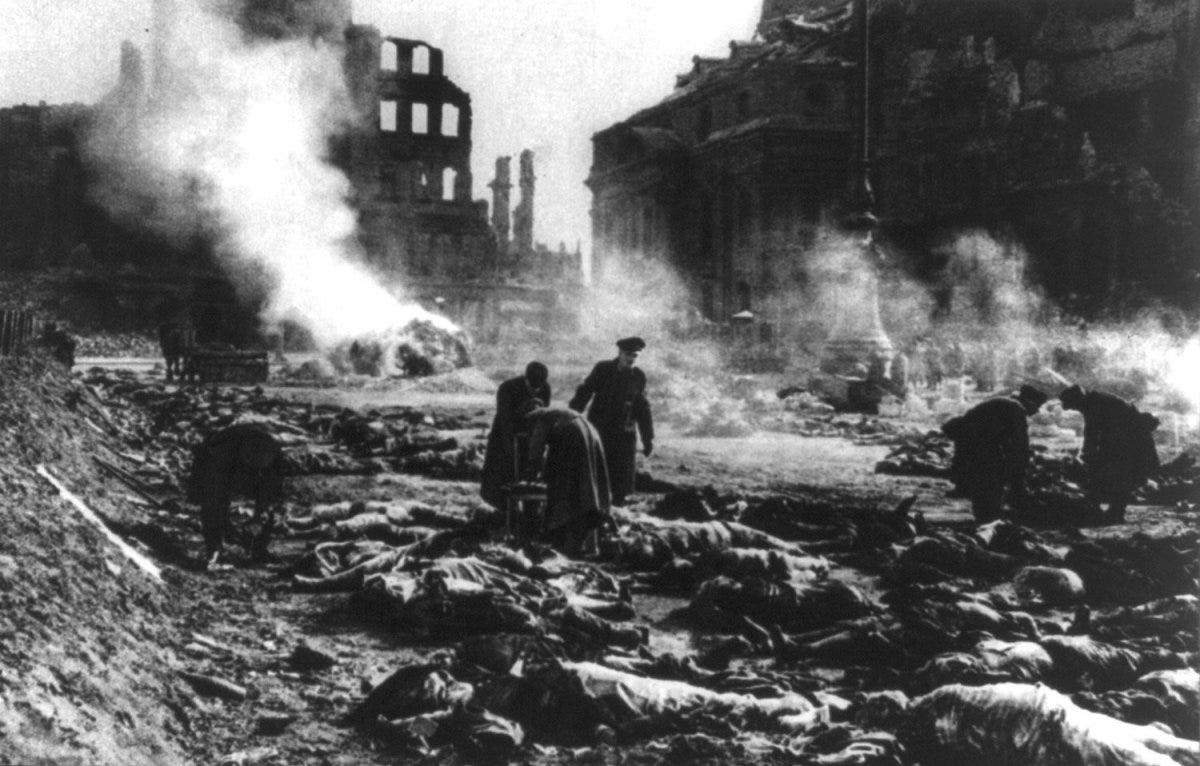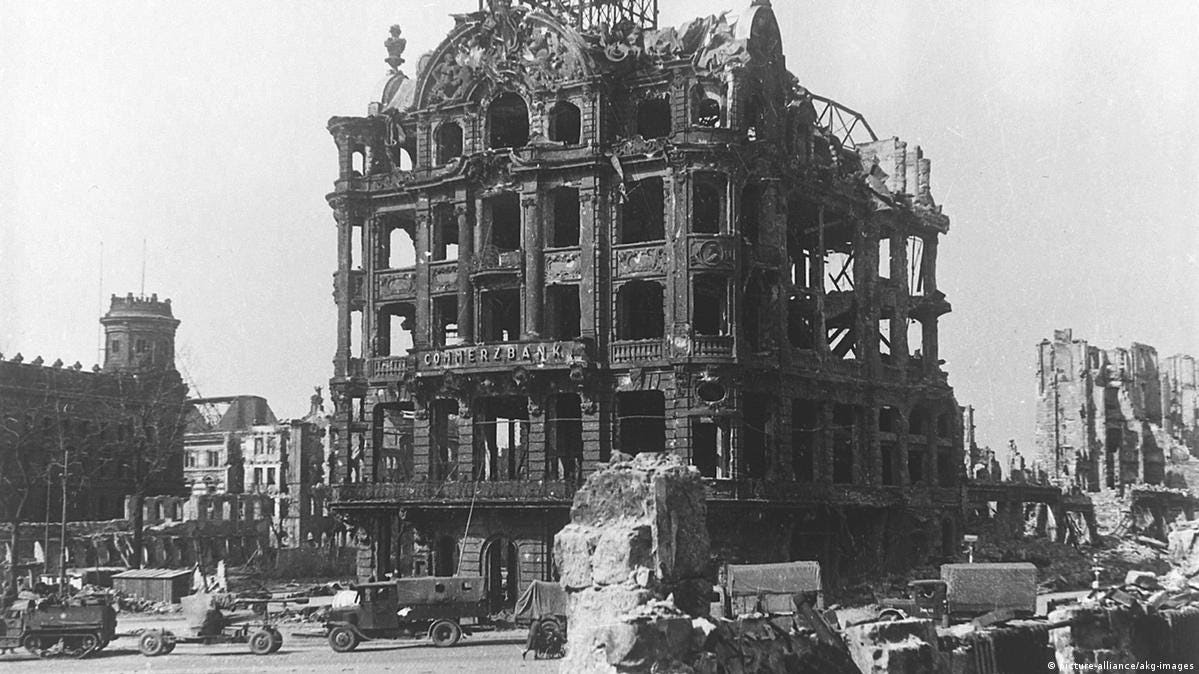Marshal Arthur Harris, the director of England’s Bomber Command decided, in mid-1941, to abandon the illusion of surgical strikes. Harris, nicknamed “Bomber,” mastered the ins and outs of committing war crimes from his insidious instructor, Winston Churchill.
The year was 1919. The Royal Air Force asked Churchill for permission to use chemical weapons “against recalcitrant Arabs as an experiment.” Churchill, secretary of state at the war office at the time, promptly consented. “I am strongly in favor of using poisoned gas against uncivilized tribes,” he explained. Bomber Harris, an up-and-coming air force officer in 1919, concurred: “They [the Arabs and Kurds] now know what real bombing means, in casualties and damage.”
Harris and Churchill teamed up again some 25 years later to execute a relentless terror bombing campaign during WWII for which neither offered any apologies nor demonstrated any qualms. “Now everyone’s at it,” Churchill said about the deliberate targeting of civilians. “It’s simply a question of fashion — similar to that of whether short or long dresses are in.”
Bomber’s attitude was best displayed when, during the later stages of the war, a motorcycle policeman stopped Harris for speeding. “You might have killed someone, sir,” came the reprimand, to which Bomber Harris replied, “Young man, I kill thousands of people every night.”
As for the Americans in the European theater, under direct orders from President Roosevelt, US bombers initially stuck to a slightly more humane policy of daylight precision bombing. Unlike their British counterparts, Americans did not have images of the Luftwaffe over London to motivate them towards unabashed mass murder; it took them a little longer to reach the point of targeting civilians as policy.
The risks of daylight bombing runs did not pay off in accuracy—only 50 percent of US bombs fell within a quarter of a mile of the target. America soon joined its English allies in the execution of nighttime area bombing campaigns of civilian targets in Germany. The saturation bombardment of Bomber Harris and his US counterparts resulted in at least 635,000 dead German civilians.
Day or night, the great number of shells falling where they were not aimed easily debunked the myth of precision. A July 24 and 25, 1944 bombing operation called COBRA called for 1,800 US bombers to hit German defenders near Saint-Lô. The planes arrived one day early and bombed so inaccurately that twenty-five Americans were killed and 131 wounded — causing some US units to open fire on their own aircraft. The next day, with the American soldiers withdrawing thousands of yards to avoid a repeat performance, the bombers still missed their mark and ended up killing 111 GIs and wounding nearly 500 more.
“In order to invade the Continent,” says historian Paul Fussell, “the Allies killed 12,000 innocent French and Belgian civilians who happened to live in the wrong part of town, that is, too near the railway tracks.”
In 1945, Britain and America added fuel to the fire.
On February 13–14, 1945 — 78 years ago today — Allied bombers laid siege to the German town of Dresden which was once known as “Florence on the Elbe.”
With the Russians advancing rapidly towards Berlin, tens of thousands of German civilians fled into Dresden, believing it to be safe from attack. As a result, the city’s population swelled from its usual 600,000 to at least one million.
Following up on a smaller raid on Hamburg in July 1943 that killed at least 48,000 civilians, Winston Churchill enlisted the aid of British scientists to cook up “a new kind of weather.”
The goal was not only maximum destruction and loss of life but also to show their communist allies what a capitalist war machine could do…in case Stalin had any crazy ideas.
An internal Royal Air Force memo described the anti-communist plans as such: “Dresden, the seventh largest city in Germany and not much smaller than Manchester, is also [by] far the largest un-bombed built-up area the enemy has got. In the midst of winter, with refugees pouring westwards and troops to be rested, roofs are at a premium, not only to give shelter… but to house the administrative services displaced from other areas… The intentions of the attack are to hit the enemy where he will feel it most…and to show the Russians when they arrive what Bomber Command can do.”
There was never any doubt on the part of the Allies exactly who they would be bombing at Dresden. Brian S. Blades, a flight engineer in a Lancaster of 460 (Australian) Squadron, wrote that during briefings, he heard phrases like “Virgin target,” and “Intelligence reports thousands of refugees streaming into the city from other bombed areas.”
Besides the stream of refugees, Dresden was also known for its china and its Baroque and Rococo architecture. Its galleries housed works by Vermeer, Rembrandt, Rubens, and Botticelli.
On the evening of February 13, none of this would matter.
Using the Dresden soccer stadium as a reference point, over 2000 British Lancasters and American Flying Fortresses dropped loads of gasoline bombs every 50 square yards out from this marker. The enormous flame that resulted was eight square miles wide, shooting smoke three miles high. For the next eighteen hours, regular bombs were dropped on top of this strange brew. Twenty-five minutes after the bombing, winds reaching 150 miles per hour sucked everything into the heart of the storm.
Because the air became superheated and rushed upward, the fire lost most of its oxygen, creating tornadoes of flame that can suck the air right out of human lungs.
Seventy percent of the Dresden dead either suffocated or died from poison gases that turned their bodies green and red. The intense heat melted some bodies into the pavement like bubblegum or shrunk them into three-foot-long charred carcasses.
Clean-up crews wore rubber boots to wade through the “human soup” found in nearby caves. In other cases, the superheated air propelled victims skyward only to come down in tiny pieces as far as fifteen miles outside Dresden.
“The flames ate everything organic, everything that would burn,” wrote journalist Phillip Knightley. “People died by the thousands, cooked, incinerated, or suffocated. Then American planes came the next day to machine-gun survivors as they struggled to the banks of the Elbe.”
The Allied firebombing did more than shock and awe. The Greatest [sic] Generation bombing campaign murdered more than 100,000 people — mostly civilians — but the exact number may never be known due to the high number of refugees in the area.
In his wartime memoirs, Sir Winston Churchill seemed unable to work up much emotion in recalling the Dresden assault. He wrote: “We made a heavy raid in the latter month on Dresden, then a centre of communication of Germany’s Eastern Front.”
It’s well-known that the victors write the history.
Let’s be the victors this time.
The post Reminder: The Greatest Generation™ Deliberately Bombed Civilians first appeared on Dissident Voice.
This content originally appeared on Dissident Voice and was authored by Mickey Z..


